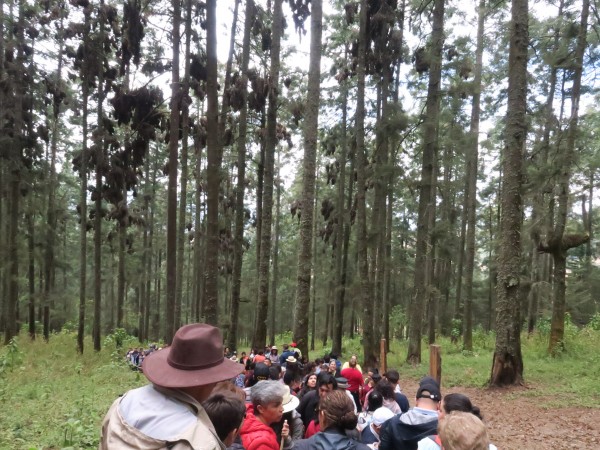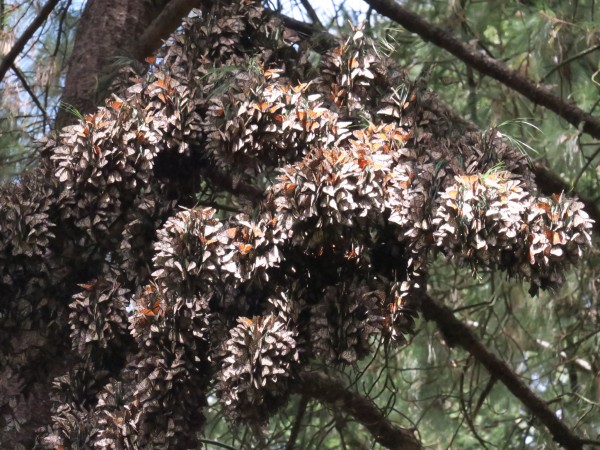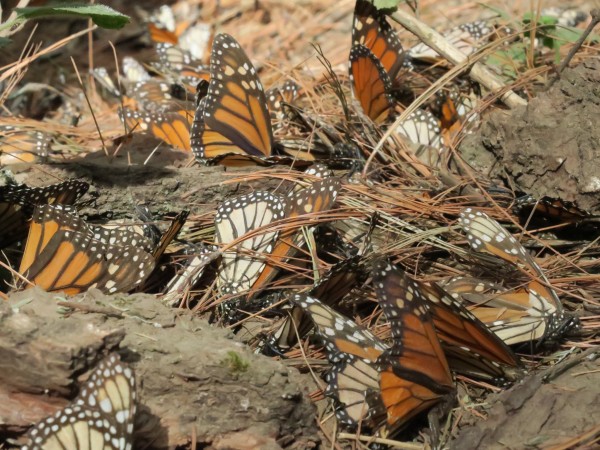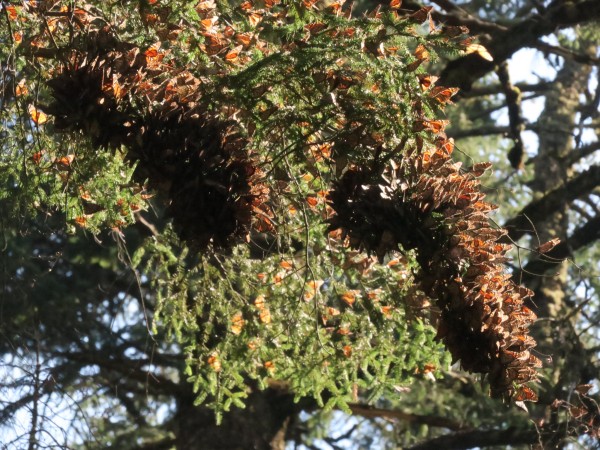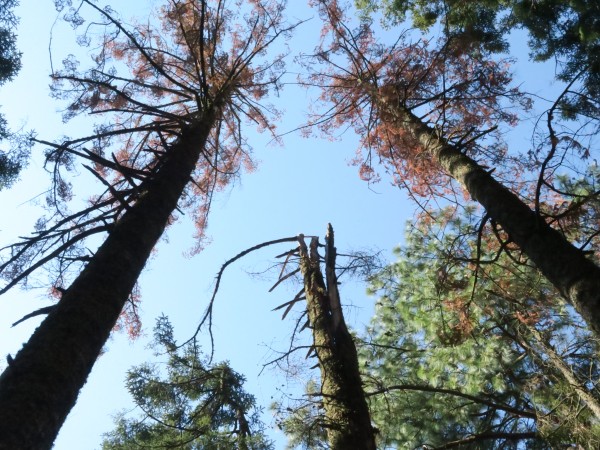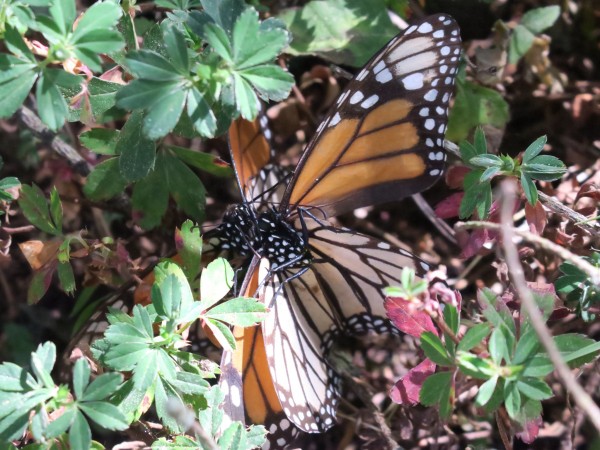Letter from Estela
Last and Final Departure Expected Any Moment!
March 19, 2019
Dear friends,
We all -- locals, experts, fans, children to seniors in all families, foreign and local visitors -- continue peeping into our forests, looking up to the sky and relaxing our upper back muscles every once in a while from twisting our necks around and around, all day long, so that we can see the last, final leaving occurring any moment now!
It seems that our temperatures keeping fresh to chilly overday and specially overnight during the last days, may be holding Monarchs from doing their last massive departure, and by this, the remaining numbers in both colonies, shall be reaching the historically registered dates of departure which have been March 18 – 30. Not to mention last spring’s very late April 6-7 departure.
El Rosario Sanctuary
El Rosario Sanctuary is still waiting for the final departure. Less than 5% of the population is remaining, with many small to medium clusters, and still a few beautiful big ones, enough for marveling the still many coming visitors up to now!
The remains of dead monarchs carpet the ground with orange-brown all over showing every case of predation as well as unknown causes of mortality. Blooming is abundant providing nectar sources all over, while ponds and streams diminish their force as heat waves hit our region in the past weeks.
There the colony remains quietly, not seeming to be in a real hurry to leave within the immediate next few days, we locals dare to believe.
Macario, age 12, elementary school grader coming with his family, from Morelia, our state capital city says:
“If I could live in a magical place like this…This is like living in the Harry Potter film. It's magic to be in a real forest were trees are really huge and fantasy things happen!”
Emmanuel, Alfonso, Jimena Yaritzi and Heréndira, all age 10, attending 5th. grade elementary and coming with their teacher from Querétaro City -- Central México, 180 km away-- went over and repeated what Estela had just tried to share with them: --the most perfectly captured and got impressed at knowing all these facts they had never imagined before coming--!.
“Oh, so our country has got the most dense Oyamel forest spots in the world and these huge trees right here are them, specially attracting Monarchs, among other facts, because of the micro-climate conditions they provide to Monarchs while they overwinter here. Monarchs feed themselves when they are caterpillars and here, they do not need –and would not have—Asclepias to eat; so they are strong enough as they leave USA and Canada, so as to stay the whole winter only getting minerals at humid soil, water at streams, sunshine under our warm-winter sun, and if necessary, some néctar awaiting for their mating phase to leave and fulfill their mission as the Mathusalen Generation!,
Raúl and Fabián, both 10, elementary school graders in México City, repeated what their local guide had just told them:
“When a butterfly has two black spots on both rear wings it is a male; when not, it is a female,” they went over and over!
A bigger group of elementary and middle school graders coming all form our far away beautiful Chiapas State, bordering with the Guatemala and Belize southern countries, all of them born and used to living in the most exuberant and amazing nature surrounding one can imagine, said:
“Oh, my heavens, we knew this was something to come and see, and even though we’ve seen images of this looking just like a dark cave with an immense population only a few weeks ago in the social nets all over… this is something different and extraordinary as a phenomenon and immigration in animal species from that what we live in and we had ever seen!"
Mariela, age 6, coming from Guadalajara city, was meanwhile indeed reinforcing her feelings on a future career on Sciences:
“I love to collect and observe leaves, twigs and animal rests, so that I can understand how important they are for us human beings”, --she said to herself, responding to Estela showing her beautiful earrings, while busy and captured in nature!--.
Last, Frida, 6, coming from Monterrey city far away in our northern states, only starting her way up into the colony showed herself off with her beautiful t-shirt on, telling what a fan she was of butterflies, with a Monarch in the middle as the Queen of all!
Sierra Chincua Sanctuary
The soil turns drier and drier as as Spring progresses. Fewer and fewer visitors come to Sierra Chincua as local guides in the Sanctuaries announce that the final leaving is actually in its very last moments. The Monarch season should finally declare its closing for this overwintering spot.
As Nicolás my excellent local guide and I got closer to the “Llano del Toro” site, where Monarchs still showed very good numbers in density up to middle of the last week, a really scarce flying or nectaring was seen.
The rather abundant perishing here and there is the only remaining evidence of the location of the 2-3 colonies around during the last weeks.
On our way in search of the possibly last remaining numbers, some signals show how intense our rain-lightning season is up here in our mountains, even burning out some huge trees. Impressive rock formations and wonderful hummingbird and bird-singing make of our over 2-hour one-way walk was an incredible experience.
Once in “Llano del Toro”, a few Monarchs overflew high up in the sky took us to a really close inside northern spot in the woods where we found the very last numbers, which should remain possibly for the next hours more after the weekend and finally leaving last Monday and Tuesday, March 18-19. Every moment, no matter in which direction, couples were noisily mating all over and more than ever! They were in the air, underneath the canopy, on plant stems and tree-twigs… they all seemed in a hurry as if really running out of time while still in their overwintering sites in México only hours before their final departure!.
Sighting and silently looking up to the sky, the whole local community in Sierra Chincua humbly express through the voice of Ambrosio and his young mother, great-grand child and grand-daughter to one of the oldest Ejidatario families in the location:
“We cannot help sadness invading us on one side, but gratefulness on the other at having witnessed one of the most exceptional seasons in population in the last years! The season is definately now over for Monarchs with us”.
“However, we want to announce the world that we families shall shift turns all year round here, from June to October, while we do reforestation, our Oyamel forests are among the best spots in the region for enjoying wild mushroom observation and collection, which samples overpass the 300 local species growing at the Monarchs’ Reserve, bird-watching, impressive rock formations and breathtaking landscapes to the mountain-chain range from the highest viewpoints in Central México”!. Ambrosio and Isabel his mother, running their local restaurant at the Sanctuary, Nicolás and Estela ended up telling friendly.
Sanctuaries will officially closing next Sunday, March 31st. While ejidatarios at Sierra Chincua have already witnessed Monarchs finally leaving their spots there, ejidatarios at El Rosario are getting ready to see the final rush taking off!
Meanwhile, Monarchs continue to marvel hundreds and hundreds of visitors who share the remaining portion of the miracle this season with the rest of the world…
Estela Romero
Journey North
Angangueo, Michoacán, México


